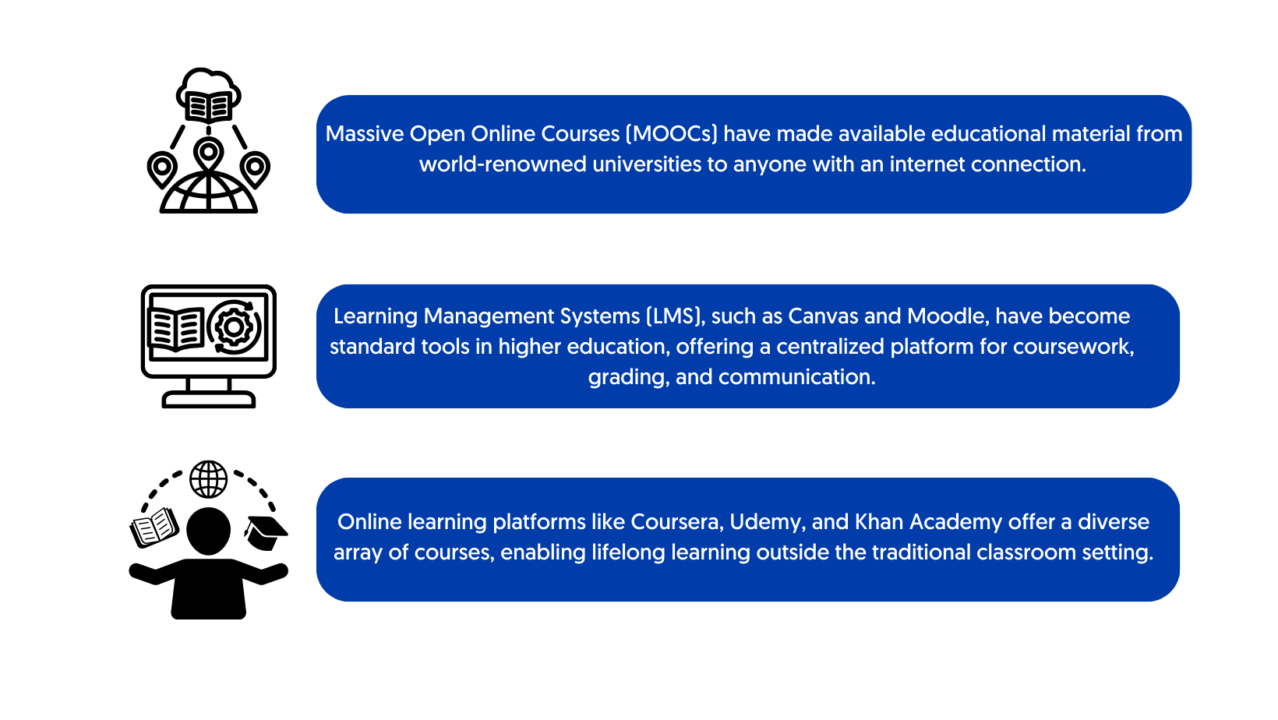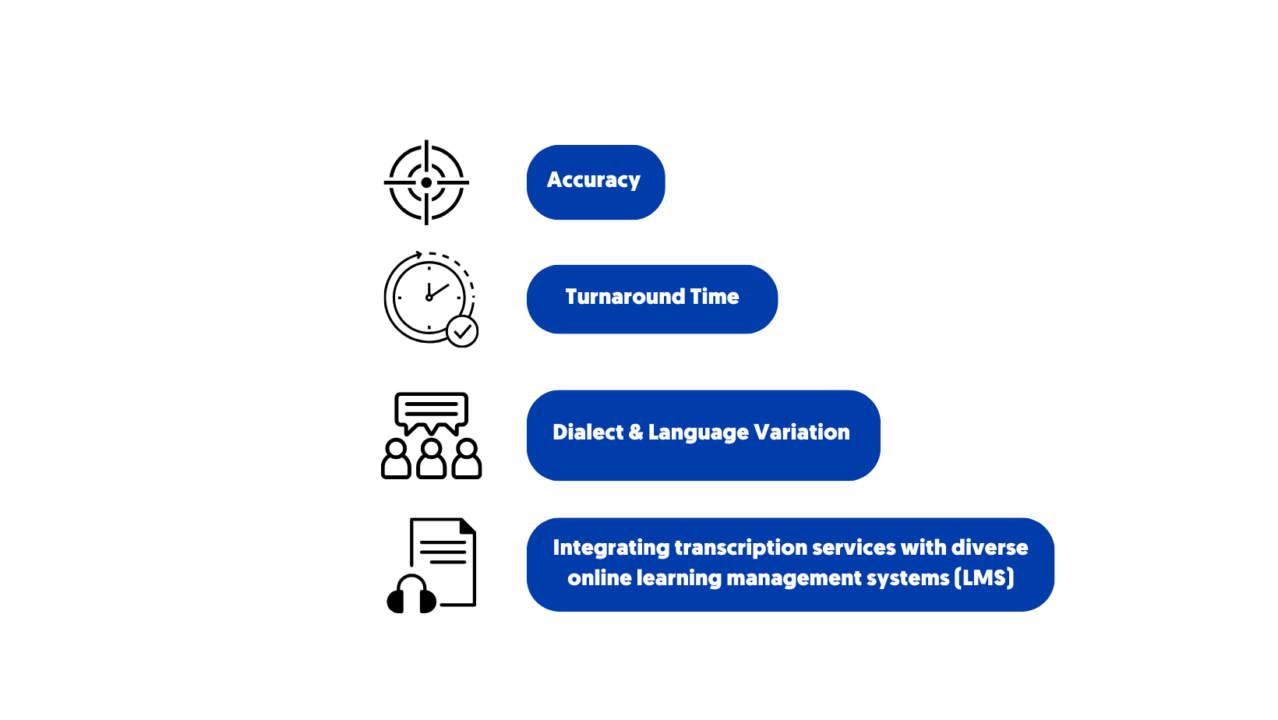Table of Contents
- Inclusivity in Online Education
- Transcriptions: A Key to Accessible Learning
- Amberscript’s Contribution to Inclusive Online Education
- Transcription in Action: Real-World Applications
- Tackling Transcription Challenges in E-Learning
- Success Stories: Universities and Amberscript
- The Evolving Landscape of Transcription in Education
Inclusivity in Online Education
Online learning platforms and courses in higher education have transformed the landscape of education, enabling increased access to educational resources globally. This digital revolution has contributed to the democratization of education, breaking down traditional geographical and financial barriers.

However, with this surge comes the critical need for inclusivity in digital learning environments. Inclusion is not merely about offering access but ensuring that everyone, regardless of their abilities, can fully participate and succeed in these settings.
- Inclusivity involves designing courses that are accessible to learners with disabilities, such as providing closed captions for video content or ensuring that course materials are compatible with screen readers.
- Inclusivity also means considering the diverse backgrounds of learners, incorporating culturally responsive teaching practices, and ensuring all students feel seen and valued in the digital classroom.
Transcription services play a crucial role in promoting inclusivity in online education. By converting spoken language into written text, these services ensure that course content is accessible to a broader audience, including those with hearing impairments or non-native speakers who may find written text easier to understand.
- Transcription services also support learning preferences, allowing learners who prefer reading to listening to engage with content in their preferred format.
- Implementing transcription services supports inclusive practices by ensuring every student has equal access to information, fostering a learning environment in which everyone can thrive.
Transcriptions: A Key to Accessible Learning
Transcriptions are textual records of spoken language. In the context of online learning, transcriptions often accompany video or audio lectures, providing a written version of the content that students can read at their pace.
- Transcriptions make it possible for individuals to access information in multiple formats, supporting diverse learning styles and preferences.
- They also facilitate ease of reference. Students can revisit specific sections of a lecture easily by referring to the transcription, without needing to rewind or fast-forward through video or audio content.
- Transcriptions serve as a valuable resource for students who want to review course material, supplement their notes, or study for assessments.
The use of transcription services significantly enhances learning accessibility.
- Transcriptions ensure that course content is accessible to individuals with hearing impairments, allowing them to engage fully with the material.
- Students for whom the content language is not their first language may find written text easier to understand than spoken language. Transcriptions support these students by providing them with a text-based version of the course content.
- Also, transcriptions assist in breaking down barriers for students with learning disabilities, such as dyslexia, who might find reading a transcription easier than following along with spoken language.
The value of transcriptions extends beyond accessibility, catering to students with different learning preferences.
- For visual learners, who comprehend information best when they see it, transcriptions provide an excellent tool for engagement and understanding.
- Kinesthetic learners, who learn best by doing, can benefit from transcriptions by highlighting, annotating, and taking notes directly on the text.
- Transcriptions also facilitate self-paced learning. Students can read at their own speed, pause to reflect, and review as necessary, enhancing their overall comprehension of the material.

Transcription for e-learning: How to make online courses more engaging
Read BlogAmberscript’s Contribution to Inclusive Online Education
Amberscript, a leading provider of transcription services, is revolutionising online education by making it more accessible and inclusive. Using state-of-the-art technology, Amberscript delivers highly accurate transcriptions, crucial for ensuring that all learners can access and fully engage with course content.
- Servicing educational institutions worldwide, Amberscript strives to support diversity and inclusion in the digital learning environment.
- Their advanced transcription services facilitate access to information in a text-based format, encouraging a more inclusive learning landscape.
Amberscript’s transcription services are powered by sophisticated speech-to-text technology capable of accurately transcribing audio and video content in real-time.

- This technology employs deep learning models, which have been trained on vast amounts of data, resulting in highly precise transcriptions.
- Despite the complexity behind the scenes, Amberscript’s interface is user-friendly, allowing educators to upload their audio or video files with ease.
- The technology also supports multiple languages, accounting for the global nature of online education.
Transcription in Action: Real-World Applications

Transcriptions can significantly enhance student engagement in online lectures and seminars. They serve as an interactive guide that students can readily refer to, helping to keep their focus and attention on the course material.
With the ability to highlight, underline, and make notes directly on the transcribed text, students actively participate in the learning process, contributing to a more profound and lasting understanding of the subject matter. Transcriptions also alleviate the stress of note-taking, freeing students to listen more attentively during the lecture or seminar. This transforms the learning experience from a passive reception of information to an active and immersive exploration of knowledge.
- In complex subject areas, such as Science, Technology, Engineering, and Mathematics (STEM), transcriptions can be invaluable. These fields often involve complicated terminologies and intricate concepts that can be difficult to grasp when delivered orally.
- Transcriptions provide students with a written record of these terminologies and concepts, allowing them to revisit, dissect and comprehend them at their own pace.
- By offering a visual representation of spoken content, transcriptions help clarify ambiguities and foster a deeper understanding of the subject matter, resulting in improved academic performance.
Additionally, transcribed materials play a crucial role in supporting research and academic development. They provide a textual record of interviews, lectures, and seminars that researchers can easily search, analyze, and reference.
- This is especially beneficial for qualitative research, where transcriptions enable researchers to capture the nuances of spoken language, such as tone and emphasis, providing richer data for analysis.
Finally, transcriptions serve as a valuable study aid, allowing students to review and consolidate their knowledge, reinforcing their academic development. In essence, transcription services are not just a tool for accessibility, but a strategic asset for academic success.
Tackling Transcription Challenges in E-Learning

- One of the principal challenges in e-learning transcriptions is maintaining high levels of accuracy. Misinterpretations or inaccuracies in transcriptions can lead to confusion or misinformation, detracting from the educational experience.
- Turnaround time is another concern. Delays in transcription services can throw off course schedules and hinder the timely progression of educational modules.
To face these issues, Amberscript utilises an innovative speech recognition technology that not only ensures more than 95% accuracy but also provides transcriptions in near real-time, ensuring course continuity and comprehensive understanding for all learners.
- Dialects and language variations pose a significant challenge in transcribing educational content. Distinct regional accents or colloquial phrases can often be misunderstood or misinterpreted by conventional transcription services.
Amberscript addresses this issue by training its machine learning models on a vast array of speech data, encompassing various dialects and languages. This robust training allows the technology to recognize and accurately transcribe a wide spectrum of language nuances, ensuring that no learner is disadvantaged due to their regional accent or dialect.
- Integrating transcription services with diverse online learning management systems (LMS) can be complex. Each platform has its unique architecture and functionalities, requiring a versatile and adaptive transcription solution.
Amberscript’s transcription services are designed with flexibility in mind. The technology can integrate seamlessly with a wide array of LMS, including Moodle, Blackboard, and Canvas, among others.
This adaptability ensures that educators can incorporate Amberscript’s transcription services into their chosen LMS with ease, thereby enhancing the learning experience for students across various platforms. Ultimately, this contributes to a more inclusive and accessible e-learning landscape.
Benefits of using Amberscript
Amberscript’s services are:
Edit your text in minutes or leave the work to our experienced transcriptionists.
Our experienced transcriptionists and thorough quality controls ensure 100% accuracy of transcripts.
Through a series of integrations and API interfaces, you can fully automate your workflows.
Your data is in safe hands. We are GDPR compliant + ISO27001 and ISO9001 certified.
Success Stories: Universities and Amberscript
In addition to the previously mentioned institutions, the University of Amsterdam, a prominent European university, has also adopted Amberscript’s services. The university has fully integrated Amberscript’s transcription services into its e-learning programs, demonstrating the adaptability and utility of Amberscript’s technology in diverse academic settings.
 |
|
The introduction of Amberscript’s services has led to measurable improvements in academic outcomes at the University of Amsterdam. Examination scores have seen an upward trend, and course completion rates have improved.
Students at the University of Amsterdam have demonstrated increased engagement with course materials and more active participation in online discussions since the implementation of Amberscript’s services. This indicates the potent role that accurate transcriptions play in driving an immersive and interactive e-learning experience.

Choosing the Right Transcription Service for Universities
Read BlogThe Evolving Landscape of Transcription in Education
- The integration of transcription technology in online education is set to evolve dramatically in the coming years. Emerging trends include real-time transcription and translation services, which will further enhance the accessibility of e-learning for students across the globe.
- Artificial Intelligence (AI) and Machine Learning (ML) are poised to revolutionize transcription services, providing unparalleled accuracy and efficiency. These advanced technologies will be capable of adapting and learning from their mistakes, constantly refining their capabilities to deliver more accurate transcriptions.
- Another promising trend is the use of voice recognition technology to personalize learning experiences. This technology can adapt to individual learner’s speech patterns, accents, and language preferences, ensuring a more personalized and inclusive learning experience.
Amberscript is committed to championing these new developments in transcription technology. The team is consistently innovating and adapting its services to stay abreast of the evolving landscape of online education through:
- Continuous refinement of its machine learning algorithms to ensure the highest levels of accuracy, even as language and dialects evolve.
- Partnerships with educational institutions and LMS providers to further integrate and streamline its services within the online learning environment.
- Expanding collaborations with academic institutions and other stakeholders in the e-learning sector. This will enable the team to gain valuable insights into the evolving needs of the e-learning community and ensure that its services continue to support and enhance online education globally
- Leveraging emerging technological trends such as AI and voice recognition to further enhance its transcription services.
- Investing in research and development to refine and expand its technological capabilities.



